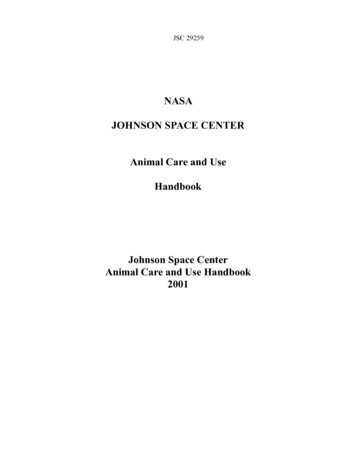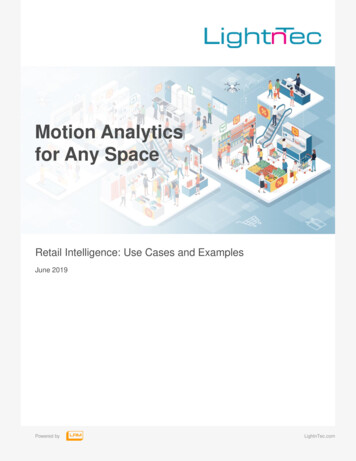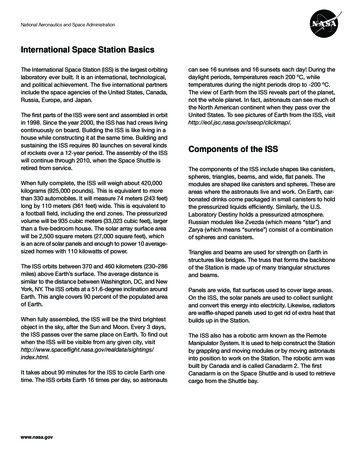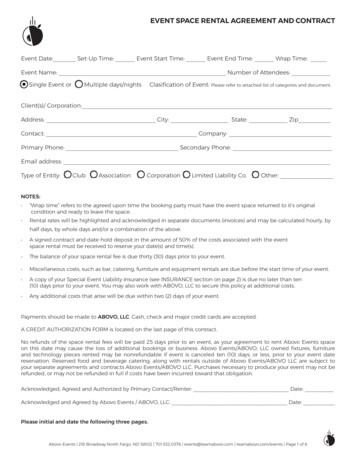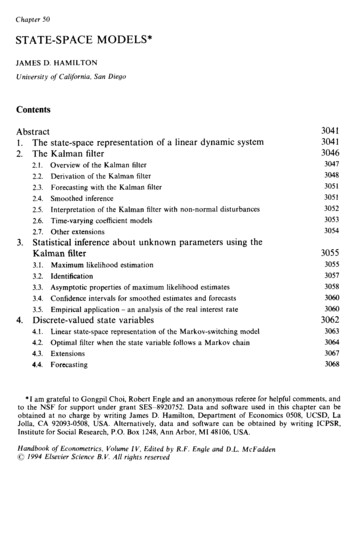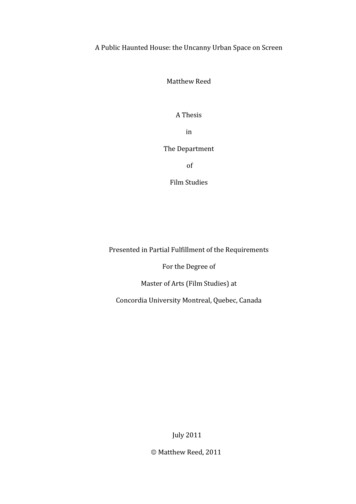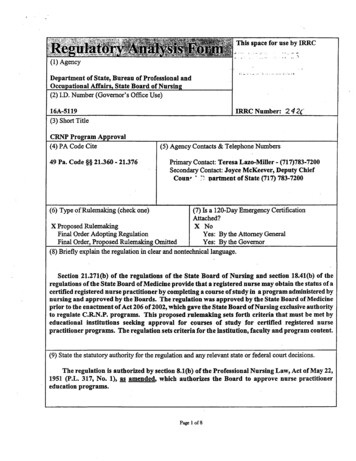
Transcription
This space for use by IRRC(1) AgencyDepartment of State, Bureau of Professional andOccupational Affairs? State Board of Nursing(2) LD, Number (Governor's Office Use)IRRC Number: 24 3f16A-5119(3) Short TitleCRNP Program Approval(4) PA Code Cite49 Pa. Code §§ 21.360 - 21.376(5) Agency Contacts & Telephone NumbersPrimary Contact: Teresa Lazo-MiDer - (717)783-7200Secondary Contact: Joyce MeKeever, Deputy ChiefConn?-* I partment of State (717)783-7200(6) Type of RulemaMng (check one)(7) Is a 120-Day Emergency CertificationAttached?X Proposed RulemaMngX NoFinal Order Adopting RegulationYes: By the Attorney GeneralFinal Order, Proposed Rulemakmg OmittedYes: By the Governor(8) Briefly explain the regulation in clear and nontechnical language.Section 21.271 (b) of the regulations of the State Board of Nursing and section 18.41(b) of theregulations of the State Board of Medicine provide that a registered nurse may obtain the status of acertified registered nurse practitioner by completing a course of study in a program administered bynursing and approved by the Boards. The regulation was approved by the State Board of Medicineprior to the enactment of Act 206 of 2002, which gave the State Board of Nursing exclusive authorityto regulate CJHLN.P. programs. This proposed ruleniaking sets forth criteria that must be met byeducational institutions seeking approval for courses of study for certified registered nursepractitioner programs. The regulation sets criteria for the institution, faculty and program content(9) State the statutory authority for the regulation and any relevant state or federal court decisions.The regulation is authorized by section 8,1 (b) of the Professional Nursing Law, Act of May 22,1951 (P,L, 317, No. 1), a§ amended, which authorizes the Board to approve nurse practitionereducation programs-Page 1 of 8
W MM% M0M i p :M (10) Is the regulation mandated by. any federal or state law or court order, or federal regulation? If yes,cite the specific law, case or regulation, and any deadlines for action.Although the regulation is not mandated by federal or state law, the Professional Nursing Lawrequires that programs for the training of nurses be approved by the Board, and the Board has notyet published regulations setting forth the criteria under which it will approve CRNP programs.(11) Explain the compelling public interest that justifies the regulation. What is the problem itaddresses?The Board's current regulations do not address approval of CRNP programs, and programapproval is done on a case-by-case basis. Because the Board does not have regulations addressing itscriteria for CRNP programs, the approval process is often lengthy and involves an excessive amountof back and forth communication between the program sponsor and the Board. The regulation willinform educational institutions of the criteria employed by the Board in approving programs, andwill standardize the education of CRNPs in the Commonwealth.(12) State the public health, safety, environmental or general welfare risks associated withnonregulation.Nonregulation could threaten public health because no standardized set of minimumqualifications exist regarding CRNP education in the Commonwealth. CRNPs practice at anadvanced level of health care practice, so standardization of these educational programs isespecially important.(13) Describe who will benefit from the regulation. (Quantify the benefits as completely as possibleand approximate the number of people who will benefit.)The regulation will benefit the administrators and faculty of institutions wishing to offer CRNPprograms by setting out the criteria that will qualify a program for approval. The regulation willbenefit prospective students by ensuring that the programs are offering the same minimum ofeducation so that graduates are competitive across the Commonwealth. The regulation will benefitthe general public by ensuring excellent educational programs for CRNPs.Page 2 of 8
(14) Describe who will be adversely affected by the regulation. (Quantify the adverse effects ascompletely as possible mid approximate the number of people who will be adversely affected,)The Board has identified no group that will be adversely affected by the regulation.(15) List the persons, groups or entities that will be required to comply with the regulation.(Approximate the number of people who will be required to comply.)All educational institutions wishing to offer CRNP programs in the Commonwealth will berequired to comply with the regulation. The Board does not know how many CRNP programs maywish to be approved in accordance with the amendments. However, currently approximately 50CRNP programs have been approved by the boards under prior law and are operating in theCommonwealth,(16) Describe the communications with and input from the public in the development and drafting ofthe regulation. List the persons and/or groups who were involved, if applicable.Pursuant to the requirements of Executive Order 1996-1, input was requested from state andregional nursing associations and schools of nursing in the Commonwealth. Pre-draft input wasrequested from the following! American Association of Neuroscience Nurses, Emergency NursesAssociation, GPC - Oncology Nursing Society, The Hospital and Healthsystem Association ofPennsylvania, Intravenous Nurse Society, Licensed Practical Nurses Association of Pennsylvania,Pennsylvania Association of Home Health Agencies, Pennsylvania Association of Private SchoolAdministrators, Pennsylvania Association of Non-Profit Homes for the Aging, PennsylvaniaAssociation of Nurse Anesthetists, Pennsylvania Association of Practical Nursing ProgramAdministrators, Pennsylvania Coalition of Nurse Practitioners, Pennsylvania College of AssociateDegree Nursing, Pennsylvania Council of Operating Room Nurses, Pennsylvania Department ofHealth-Bureau of CH Systems, Pennsylvania Health Care Association, Pennsylvania HigherEducation Nursing Schools Association, Pennsylvania League for Nursing, Inc., PennsylvaniaOrganization of Nurse Leaders, Pennsylvania Society of Gastroenterology Nurses and Associates,Pennsylvania State Nurses Association, School Nurse Section, Southwestern PennsylvaniaOrganization for Nurse Leaders, Pennsylvania Medical Society, Nurses of Pennsylvania, PennsylvaniaAssociation of School Nurses and Practitioners, Pennsylvania Nurses Association, and ProfessionalNursing Resources, Inc.(17) Provide a specific estimate of the costs and/or savings to the regulated community associated withcompliance, including any legal, accounting or consulting procedures which may be required.There are no costs or savings to the regulated community (nurses) because the regulation is directedat institutions that offer CRNP educational programs. Some CRJNPS who teach in programs mayexperience the cost of maintaining national certification; however, it is anticipated that the institutionemploying these CRNPs as professors will pay these costs. The CRNP programs will incur some costsin preparing the application for approval of a new program. The Board estimates this cost at 675,which includes the 475 application fee set forth in §21.5. The Board anticipates appronmately twoto three new programs will ask for approval over the next five years.In addition, the approximately 50 currently operating programs will incur costs of approximately 1,250.00 for the annual report and approximately 1,500,00 for the triennial compliance review.Page 3 of 8
(18) Provide a specific estimate of the costs and/or savings to local governments associated withcompliance, including any legal, accounting or consulting procedures which may be required.There are no known costs or savings to local governments associated with compliance.(19) Provide a specific estimate of the costs and/or savings to state government associated with theimplementation of the regulation, including any legal, accounting, or consulting procedures which maybe required.There are no costs or savings anticipated to state government in implementing the regulation.Page 4 of 8
(20) In the table below, provide an estimate of the fiscal savings and costs associated withimplementation and compliance for the regulated community, local government, and state governmentfor the current year and five subsequent years.Current FYYearFY 2YearFY 1YearFY 3YearFY 4YearFY 5YearN/AN/AN/AN/AN/AN/A 1,250.00 2,937.50 2,937.50 4,437.50 2,937.50 2,937.50Total Costs 1,250.00 2,937.50 2,937.50 4,437.50 2,937.50 2,937.50REVENUE yLocal GovernmentState GovernmentTotal SavingsCOSTS:RegulatedLocal GovernmentState GovernmentRegulatedLocal GovernmentState GovernmentTotal Revenue Losses(20a) Explain how the cost estiirates listed above were derived.50 current programs x 25.00 (estimated annual report cost) 1,250.00 (cost per year) This costis derived from the conclusion that all the information required to complete the annual report isalready maintained by the CRNP educational programs and the only expense is transferring theinformation to the form provided by the Board.50 current programs x 30.00 (estimated triennial compliance review cost) 1,500.00 (every 3yrs.) This cost is derived from the conclusion that all the information required to complete thetriennial compliance review is already maintained by the CRNP educational programs and the onlyexpense is transferring the information to the form provided by the Board.2 to 3 new programs seeking approval per year x estimated cost of application and cost to preparedocuments for Board review, including copying and mailing or 2.5 x 675 1687.5 annually.The cost to the Board for reviewing the reports and monitoring the program compliance with theregulation is estimated at 1,100.00 per year for the annual report and 1,100.00 every three years forthe compliance review. This operating cost of the Board is paid in fees remitted to the Board by theBoard's approximately 250,000 licensees and therefore not included above.Page 5 of 8
mmm B (20b) Provide the past three year expenditure history for programs affected by the regulation.ProgramState Board ofNursingFY-98-99 3,922,622.16FY -99-00 4,514,839.67FY-00-01 AS OF BUDGETED FY12/31/0101-02 4,827,000.00 4,934,157.00(21) Using the cost-benefit information provided above, explain how the benefits of the regulationoutweigh the adverse effects and costs.The costs of the regulation are borne by the institutions wishing to open new CRNP educationalprograms and these programs obtain economic benefit from operating the program. TheCommonwealth has seen an increase in new nursing programs at the LPN and RN level. As theseprograms incur similar costs in complying with almost identical regulations, the Board believes thatthe programs themselves believe that the costs of compliance are outweighed by the benefits of theregulation in leveling the playing field between different programs. In addition, there areimmeasurable benefits to the public in assuring a standard of competence in the education of nursesin the Commonwealth, most of who stay and practice nursing in the Commonwealth.(22) Describe the nonregulatory alternatives considered and the costs associated with those alternatives.Provide the reasons for their dismissal.Because the Professional Nursing Law mandates that the Board implement binding standards ofconduct through the promulgation of regulations, no non-regulatory alternatives were considered.(23) Describe alternative regulatory schemes* considered and the costs associated with those schemes.Provide the reasons for their dismissal.Extensive input regarding this regulation was received from the Board's educational consultants,and this input was considered and incorporated in the proposed regulation.One of the most debated requirements of the proposed regulation was whether the programdirector must have an earned doctorate degree at the time the program is established. In order toallow institutions greater flexibility in hiring a director, and give currently-approved institutionsadequate time to comply with the regulation, the Board determined that a director with a specificplan to complete doctoral preparation could serve as the director of the program. See § 21.364(b).Page 6 of 8
(24) Are there any provisions that are more stringent than federal standards? If yes, identify the specificprovisions and the compelling Pennsylvania interest that demands stronger regulation.No federal standards exist for the training of CRNPs.(25) How does this regulation compare with those of other states? Will the regulation put Pennsylvaniaat a competitive disadvantage with other states?Sixteen state boards of nursing, including those in Maryland and Delaware, approve educationalprograms for nurse practitioners. Pennsylvania has, by far, the largest number of nurse practitionerprograms, 52, followed by New York, 45, Michigan, 25 and Connecticut, 9. Twenty states require theMSN for nurse practitioners, including New Jersey, New York, Ohio and West Virginia.The Board's proposed regulation is consistent with the regulations in Maryland, Delaware andNew York and will not put Pennsylvania at a competitive advantage. The regulations all provide forminimum faculty qualifications, student-faculty ratios, surveys of programs, provisional orconditional and full approval, etc. The regulations all provide for the relationship between thenursing education program and the college or university housing the program, and specifyrequirements for student records and the school bulletin. The regulations also all provide for specificcurriculum content, educational facilities, including clinical settings, and offices for staff. See Code ofDelaware Regs § 24-1900(4.0); Code of Maryland Regulations §§ 10.27.03.01-10.27.03.19; N.Y. Educ.Regs, part 52.(26) Will the regulation affect existing or proposed regulations of the promulgating agency or otherstate agencies? If yes, explain and provide specific citations.The regulation will not affect any existing or proposed regulation of the Board or other stateagencies.(27) Will any public hearings or informational meetings be scheduled? Please provide the dates, times,and locations, if available.The Board welcomes the participation of schools of nursing and other interested parties and setsmeeting times upon request at its monthly meetings. Meeting dates for 2003 may be obtained fromthe Board's administrative office.Page 7 of 8
(28) Will the regulation change existing reporting, record keeping, or other paperwork requirements?Describe the changes and attach copies of forms or reports which will be required as a result ofimplementation, if available.The regulation does not change existing reporting requirements. Educational institutionswishing to implement a CRNP program must currently submit a written plan to the Board. Theregulation specifies information that must be included in the plan submitted to the Board. Section2L375(b)(l)(i) requires that institutions maintain student records for 50 years. This is the standardtime period for maintaining academic records.(29) Please list any special provisions which have been developed to meet the particular needs ofaffected groups or persons including, but not limited to, minorities, elderly, small businesses, andfarmers.No specifically affected groups have been identified.(30) What is the anticipated effective date of the regulation; the date by which compliance with theregulation will be required; and the date by which any required permits, licenses or other approvals mustbe obtained?The regulation would become effective upon final publication in the Pennsylvania Bulletin.(31) Provide the schedule for continual review of the regulation.The Board continuously monitors its regulations, and the Advanced Practice Committee of theBoard meets at least 4 times per year to review regulations related to advanced practice nursing.Page 8 of 8
FEE REPORT FORMAgency:State - BPOAContact:Scott MessingPhone No,783-7194Date: 4/3/2003Fee Title, Rate and Estimated Collections:Application Fee: Approval of Certified Registered Nurse Practitioner EducationProgram: 475.00Estimated Biennial Revenue: 1,900.00(4 applications x 475.00)Fee Description:The fee will be charged to evaluate each application for approval of a new nursingeducation program in Pennsylvania.Fee Objective:The fee should (1) offset the identifiable costs incurred by the State Board of Nursing toreview and process an application for approval of a new nursing education program and(2) defray a portion of the Board's administrative overhead.Fee-Related Activities and Costs:Staff time- review and prepare applicationBoard administrator - evaluate applicationAttorney-avg. time to review legal issuesBoard Mtg: - review/discussProf. Staff- evaluate & make recommendationExec. Sec. - avg. time per app:Administrative Overhead:(.17 hr)(.08 hr)(.50 hr)(.50 hr)(3.33 hr)(.08 hr)Total Estimated Cost:Proposed Fee:3.382.5225.63300.00131.133.748.21474.61 475.00Analysis, Comment, and Recommendation:It is recommended that a fee of 475.00 be established to review and evaluate anapplication for approval of a new Certified Registered Nurse Practitioner program inPennsylvania.
Page 2 Application Fee-Approval of New Certified Registered Nurse PractitionerEducation Program:Board Staff: Reviews application for approval to establish a new state-approved nursingprogram. An on-site survey is conducted by a Nursing Education Advisor; surveyincludes review of all physical resources and facilities.Application also requires review of physical facilities, blueprints, curriculum, budget,student services, administration, teaching and instructional personnel and policies, libraryand other learning resources.Because expenses vary widely, the fee proposed here covers only minimal staff time andthe administrative overhead charge.
CDL-1FACE SHEETFOR FILING DOCUMENTSWITH THE LEGISLATIVE REFERENCE BUREAU* » ? *A.r(Pursuant to Commonwealth Documents Law)&242CCopy below i s h e r e b y approved a s t oform and l e g a l i t y .A t t o r n e y GeneralDO NOT WRITE IN THIS SPACECopy below is hereby certified to be a true and correctcopy of a document issued, prescribed or promulgated by:Copy below is approved asto form and legality.Executive or IndependentAgencies.State Board of Nursing(DEPUTY ATTORNEY GENERAL)MAY 2 6 2004(AGENCY)DOCUMENT/FISCAL NOTE NO. 1 6 A — 5 1 1 9DATE OF ADOPTION:rfATE tfF APPROVALDATE OF APPROVALL AJUfc *SHLJE*U Janet Hunter Shields, MSN, CRNP, CS(Deputy General Counsel(01'iief Ctounjffl,I Mill limnle ill HIJI ill VE OFFICER, CHAIRMAN OR SECRETARY)C][]Check if applicableCopy not approved.Objections attached.Check if applicable. No AttorneyGeneral approval orobjection within 30 dayafter submission.f U pOSect «& *JCOMMONWEALTH OF PENNSYLVANIADEPARTMENT OF STATEBUREAU OF PROFESSIONAL AND OCCUPATIONAL AFFAIRSSTATE BOARD OF NURSING49 PA. CODE, SECTIONS 2 1 . 3 6 0 - 2 1 . 3 7 7CERTIFIED REGISTERED NURSE PRACTITIONER PROGRAM APPROVAL
16 A-5119 PreambleCRNP Program Approval ProposedAugust 11,2004The State Board of Nursing (Board) proposes to amend its regulations by adding newsections related to the approval of certified registered nurse practitioner educational programs at49 Pa. Code §§ 21.360 - 21.376.Effective DateThe amendments will be effective upon publication of the final-form rulemaking in thePennsylvania Bulletin,Statutory AuthorityThe amendments are authorized under sections 6.1 and 8.1 of the Professional NursingLaw (Act), Act of May 22,1951, P.L. 317, as amended. (63 P.S. § 216.1).Background and Need for the AmendmentIn 1974, the Legislature, in amendments to the Act and the Medical Practice Act of 1974,authorized the Board and the State Board of Medical Education and Licensure (now the StateBoard of Medicine) to jointly promulgate regulations which
regional nursing associations and schools of nursing in the Commonwealth. Pre-draft input was requested from the following! American Association of Neuroscience Nurses, Emergency Nurses Association, GPC - Oncology Nursing
